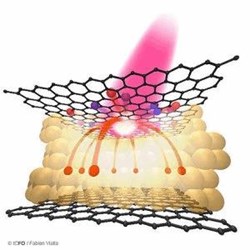2D Graphene Photodetectors Offer Path To Novel Optoelectronics

A novel way to detect and harvest low-energy photons using heterostructures made of 2D materials and graphene may overcome the limitations of conventional semiconductor devices, and could lead to greater speed and efficiency in optoelectronic applications. The technique — termed the photo-thermionic effect — makes use of the optical properties of graphene including graphene’s broadband absorption, ultrafast response and gate tunability.
A number of photodetectors rely on the emission of photoexcited charge carriers. These carriers are typically injected over a Schottky barrier between a metal and a semiconductor, allowing the detection of photons with energy lower than the semiconductor bandgap. However, the efficiency of this mechanism drops for photon energy lower than the Schottky barrier height ΦB and is limited by the ability to extract the carriers before they lose their initial energy.
To overcome such limitations when detecting and harvesting low-energy photons, researchers at the Institute of Photonic Sciences (ICFO) and its Catalan Institute of Research and Advanced Studies (ICREA) made vertical heterostructures by stacking graphene and other 2D semiconducting materials. They studied the photoresponse in these structures, demonstrating that it is possible to generate a current by heating electrons in graphene with IR light and extracting the hottest electrons over a vertical energy barrier.
The researchers found that heterostructures made of 2D materials and graphene can be used to detect low-energy photons, which could lead to novel optoelectronic applications such as high-speed integrated communication systems and IR energy harvesting.
The absorbed photon energy in graphene was transferred to the electron bath, leading to a thermalized hot carrier distribution. Carriers with energy higher than the Schottky barrier between graphene and WSe2 could be emitted over the barrier, thus creating photocurrent.
The researchers demonstrated that the photo-thermionic effect may enable detection of sub-bandgap photons. Devices relying on this effect make use of the entire surface of graphene, and can potentially be scaled up and integrated with flexible or rigid platforms.
"This is just the tip of the iceberg, these 2D sandwiches still have a lot to reveal,” said Frank Koppensn, a professor at ICREA.
The research was published in Nature Communications (doi: 10.1038/ncomms12174).
Source: The Institute of Photonic Sciences (ICFO)
